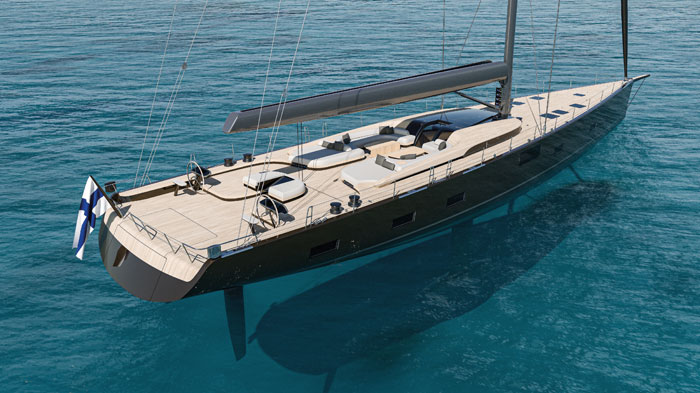

The latest collaboration between Baltic Yachts and Malcolm McKeon Yacht Design puts equal emphasis on performance, elegance, efficiency and easy handling, with some unique and interesting features
What happens when an experienced, knowledgeable couple of ocean cruising sailors complete a full circumnavigation and then spend about 10 years developing and refining the concept for their ideal high-performance world cruising yacht, before finally getting Malcolm McKeon to design it and Baltic Yachts to build it?
This is the result. Currently in build and due for delivery in 2023, the Baltic 110 is an impressively elegant full custom design with serious performance potential, state-of-the-art systems and some interesting features. It’s quite different to the recent McKeon-designed Baltic 112 Liara, which is more of a racercruiser. And while it shares a broadly similar ethos in terms of performance and blue water cruising with the Baltic cutters designed by judel/vrolijk, such as Baltic 112 Canova and Baltic 146 Path, the new 110 is primarily a sloop and will be distinctly different not just in style but also in functionality.
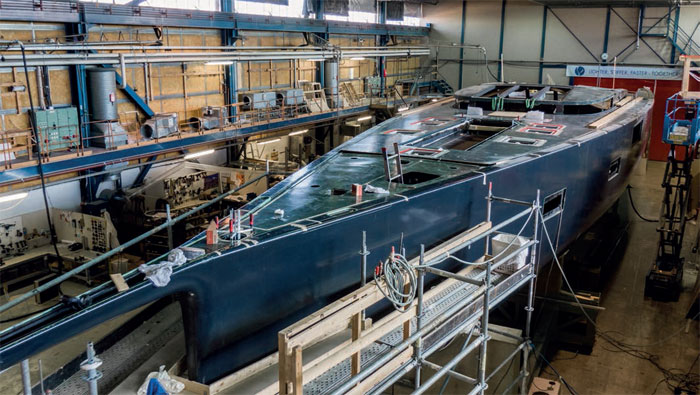
‘The McKeon pen can certainly be seen in some of the external styling features, otherwise the big differences are in the systems design with an electric drive and high-voltage battery banks,’ says Baltic Yachts’ executive vice president Henry Hawkins. One benefit of this project’s 10-year gestation period, he explains, ‘is the possibility to take advantage in the advancement of battery technology and electric motors.’
The owners of the 110 carefully weighed up the pros and cons of full custom and semi-custom yachts, with support from the highly knowledgeable team at A2B marine consultants, before deciding to have this one built. ‘The tipping point was to be able to build exactly what they wanted without compromising in any area – a once in a lifetime project,’ Hawkins says. ‘Baltic’s experience on the hybrid technology side through our recent builds was also a deciding factor. This boat will be larger than their previous yacht but will have within it all their ideas developed from their previous boats.’
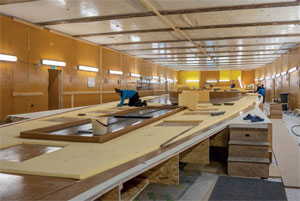
Concept
Before commissioning a naval architect to design the yacht, the owners appointed a land-based architect, Andreas Martin-Löf Arkitekter, as their interior designer and general style consultant. Renowned for his warm minimalist aesthetic and innovative use of light, Martin-Löf brings a unique perspective and fresh ideas to the project because this was the first yacht design commission for his Stockholmbased design office. It wasn’t his first yacht design project, though, as Martin- Löf had recently designed the superstructure and interior for his own 11-metre boat.
‘For us it was crucial to work with an interior designer with land architecture experience, the Baltic 110’s owner explains. ‘Together we could challenge ourselves and the way of thinking when building our new yacht.’ The owners and Martin-Löf visited 15 yachts of a similar size from various shipyards and naval architects, interviewing their owners and crew to refine, focus and develop the concept for the 110.
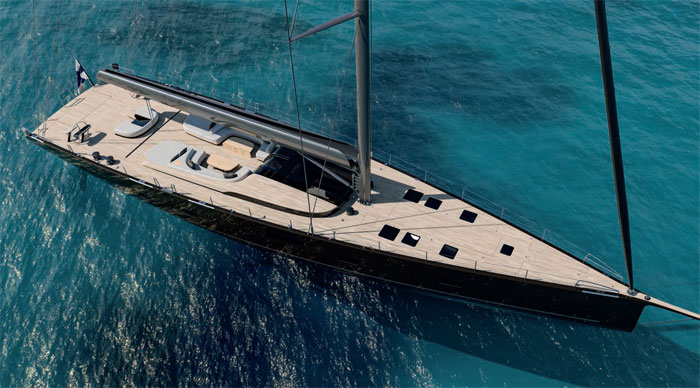
The working jib and staysail are hoisted on soft stays from a dedicated locker in the middle of the foredeck
‘Andreas and his team have played a very important role throughout our 110’s development,’ the owner says. ‘With their curiosity, professional approach and sensitivity to the yacht builder’s experience we have found a way to create the “warm minimalism” we were aiming for.’ This research led them to choose McKeon Yacht Design and Baltic Yachts.
‘What appealed to me about Baltic when we were looking at builders was the company’s approach to fully custom interiors and that the solutions we were proposing were being taken very seriously,’ says Andreas Martin-Löf. ‘Baltic is curious about testing things and appreciates the aesthetic in design. We also liked Baltic’s attitude towards sustainability with the issues about emissions giving way to electric propulsion, for instance.’
‘The design brief was for a performance cruising yacht capable of world cruising with the owner’s family in comfort and safety,’ says Malcolm McKeon. ‘Another key request from the client was to design and build a yacht that can run as efficiently as current technology will reliably allow.’
‘High on the list of priorities was performance as the owners are keen sailors and very much enjoy sailing in all conditions. At some point the Baltic 110 will partake in some of the Bucket regattas but initially world cruising in a comfortable and reliable yacht is their priority.’
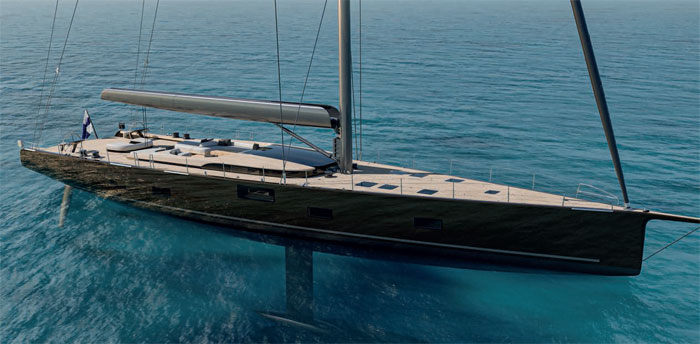
The 110 has twin rudders and a telescoping keel with a draught of 3.95m to 6m. The furling padeye on the stem is for a code sail
‘The 110 will cruise worldwide and to remote destinations,’ Hawkins says. ‘The owners will be on board for longdistance passage making. She will not charter and most likely will operate with four or five crew.’
Hull, keel and rudders
‘The Baltic 110 is overall a new concept however there are certain elements that have evolved from our earlier designs,’ McKeon says. ‘The hull shape is an easily driven form with relatively broad aft sections to enhance reaching performance. Twin rudders will make the yacht easy to control and still light on the helm in the more extreme conditions.’ Like nearly all Baltic yachts there will be a direct connection between the wheels and rudders, precisely balanced and engineered to deliver the optimum ‘feel’ and feedback at the helm.
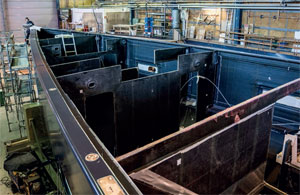
The decision to build the yacht in hi-tech carbon composite, rather than aluminium or GRP, reduces the weight of the hull by about 20 tons – which is around 22 per cent of the total light ship displacement – while also giving it more structural stiffness. ‘Building in carbon to save weight wherever possible is key to building a performance sailing yacht,’ McKeon says. The keel will be made by APM to a design developed in collaboration with Baltic Yachts. ‘A lifting keel is paramount for performance sailing as it provides a relatively deep draught with the keel down but does not limit cruising areas when the keel is retracted,’ McKeon says. ‘The Baltic 110 has a telescoping lifting keel which does not impact on the accommodation spaces as the keel head is contained within the engine room.’ This neat and efficient solution provides 28 tonnes of ballast and a variable draught of 3.95m to 6m but it does create an extra challenge for the builder, as Hawkins says: ‘As always the biggest challenge has been to fit everything into the engine room.’
Deck plan
The foredeck is completely flush with seven skylight hatches, the low-profile deckhouse has a glass roof and the large passenger cockpit has tapered coamings that provide secure seat backs for the forward lounge area and a more open aspect for the twin sunpads aft. The twin helm pedestals are set outboard and slightly lower, aft of the working area for the crew where the mainsheet traveller runs almost full beam beneath the deck and four primary winches for headsails, code sails and gennakers are mounted on the gunwales, two on each side.
Interior design
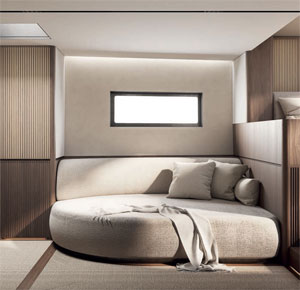
The upper and lower saloons feel connected to each other and the glass coachroof floods the deckhouse with natural light
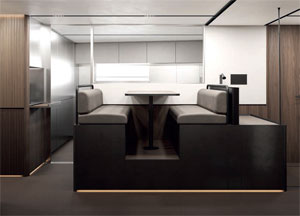 Even the crew’s mess is finished in Martin-Löf’s signature warm minimalist style
Even the crew’s mess is finished in Martin-Löf’s signature warm minimalist style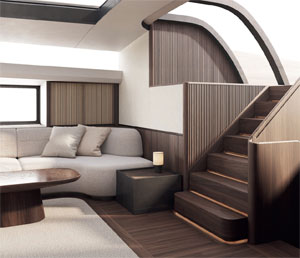
Throughout the interior a two-tone palette contrasts pale tones above waist height with dark tones below
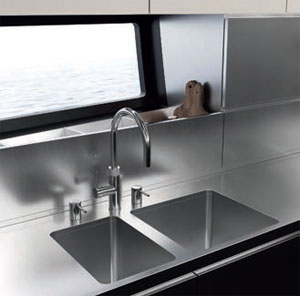
In the galley stainless steel worktops match the appliances and are offset with white surfaces and headlining
One upshot of Martin-Löf’s visits to other yachts was a determination to create a less busy interior by reducing the clash of materials, textures and colours that are typically used in a large yacht interior. ‘I started by questioning some quite basic things that have been done the same way for decades,’ he says.
The result is a lot less visual clutter and a 30 per cent reduction in joins and connections between different parts of the interior fit-out. Where these are needed, they are exploited for other uses – for example lighting fixtures are set into the joins between headlining panels. The mainsheet tie-rod running through the navigation area is disguised with a blackened steel tube aligning with a panel divide.
Other defining elements of his work include careful selection of hardware, with hinges, handles and taps in bronze or similar dark treated metals, and a two-tone colour palette throughout the yacht with dark walnut on the sole and the lower halves of vertical surfaces contrasting with pale surfaces above. Sinks and showers are clad in limestone veneer with shadow gaps to give fixed units a free-standing impression, and Japanese rice paper is used with strips of solid walnut to create lanterns set into the corners of interior spaces to brighten up the parts of the interior that are usually dark.
Nearly all interior structure and furniture is super-light honeycomb construction with thin veneers of wood, paper and stone bonded on top. The doors, however, are milled from solid walnut. The main saloon in the deckhouse has very large through-hull windows with wide, cushioned 1.8m long sills beneath them, offering guests a comfortable nook to lie down and relax with a spectacular view. In the galley, stainless steel work tops match the fridge and freezer doors and combine with a natural cork sole and white headlining for a simple, clean overall effect.
‘The deckhouse is a new and contemporary concept,’ McKeon says. ‘The drive was to keep the profile as low and sleek as possible whilst still allowing a light and airy feel to the interior. This is achieved by the continuous saloon window and largely glass roof which runs the length of the cabin top and connects to the saloon doors. The cockpit and saloon spaces will feel connected through the full width glass sliding doors. We have also developed a stylish cockpit enclosure arrangement which connects the dodger and bimini so that the whole cockpit can be enclosed for the more extreme north and south cruising latitudes.’
Rig and sailplan
The rig package is a collaboration between McKeon and Southern Spars. ‘We have worked closely with them on several projects to develop high performance rigs while maintaining good safety margins and ease of handling for cruising use,’ McKeon says. ‘For this project in particular, the option to fit a square top mainsail and running backstays for future racing was important and allows the best of both worlds. However, with the heavily raked mast spreader arrangement the running backstays are not super critical in a tack or gybe so shorthanded sailing will be easily manageable.’
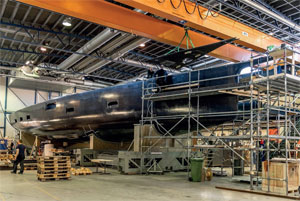
With a light ship displacement of 91 tonnes and 638sq m of upwind sail area in a 365sq m pinhead mainsail and 273sq m blade jib, the Baltic 110 should be a powerful performer even in cruising mode. Its sail area : displacement ratio (SA/D) of 32 in that configuration is already more akin to a racer than a cruiser and a square top main will give an extra 55 square metres, boosting the boat’s SA/D to almost 35. Downwind, 1,255sq m of sailpower (or 1,310 with the square top mainsail) will ensure fast ocean passages.
Despite the focus on performance, this yacht is conceived as an all-rounder that can be easily handled by a small crew. ‘When designing a yacht that is to perform well across the wind range, it is important to make sure that there is sufficient sail area to maximise light air performance whilst tuning the yacht’s stability, so reefing is not required in normal trade wind conditions,’ McKeon explains. ‘We will expect to start reefing in around 16/17kts of true wind speed which is around 25/27kts apparent wind speed.’
The sailplan aims to combine the advantages of a pure sloop rig with the benefits of a cutter. ‘There is a single fixed headstay which makes tacking the yacht simpler and more enjoyable when sailing shorthanded,’ McKeon says. ‘The working jib and staysail are hoisted on soft stays from a large foredeck centre line deck locker which will make hoisting and stowing sails much quicker and easier. These two sails are then connected to under-deck furlers with internal tensioning rams.’
‘The headsails sheets are led to the aft deck winches through a deck bridle arrangement which allows for infinite sheeting angles for all points of sailing. Whilst the bridle system is a benefit when racing it also makes shorthanded cruising all the more enjoyable as the sails can be trimmed easily using the under-deck hydraulic rams connected to the bridle. The mainsheet and main halyard are on captive winches as this is the most efficient way to integrate the handling with a boom furling system.’
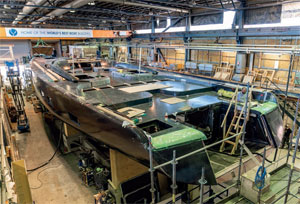
One notable feature of this yacht’s aesthetic is at the sharp end, where the gennaker and code sails will be flown from the end of a bowsprit that is fully integrated and carefully styled. ‘Bowsprits are not normally the most elegant part of the bow design so we have paid special attention to blending the sprit into the shape of the bow and minimising the size of the sprit head,’ McKeon says.
Next level efficiency
The 110 will be the third Baltic yacht with an electric propulsion system using the well proven Danfoss Editron motor, this time driving a conventional shaft, with Esoro lithium-ion batteries (120kWh gross / 110kWh net output) and twin 129kW Cummins diesel generators that are designed to meet IMO Tier 3 emissions regulations. Under sail, the freewheeling propeller will regenerate a useful amount of power.
This setup, already deployed in the Baltic 142 Canova and Baltic 117 Perseverance, is highly efficient and much quieter than a conventional diesel engine with a lot less vibration. It also meets another important requirement in the owners’ design brief, to create a reliable and failsafe ocean cruiser. ‘There have been no major steps since Canova,’ Baltic’s electrical system design engineer Kim Kolam says. ‘But the details in many parts of the control and distribution have been improved.’
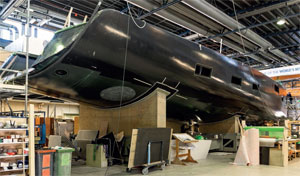
There is more redundancy built into this hybrid system than a conventional diesel drivetrain, Kolam explains. ‘At sea, power can be taken from any of the two battery banks or two generators – four sources in total. The electric drivetrain is divided into two identical halves, each of which can propel the yacht at half speed as the motor itself has double windings connected to double inverters.’
The high-voltage system also powers the pumps that drive the yacht’s hydraulic sailing systems but it’s stepped down through inverters to supply the yacht's hotel loads.
With just one generator running to conserve fuel, the Baltic 110 is expected to have a cruising range of about 2,000 miles at nine knots with full hotel load. On battery power alone, assuming 8kts boatspeed with a power consumption around 50kW and an additional hotel load of roughly 15kW, the yacht should be able to run for at least an hour and a half, quite possibly two hours, before reverting to diesel-electric mode.
‘All manoeuvres can be done with battery power only,’ Kolam says. ‘At cruising speeds above about eight knots at least one generator must be running. So as a whole, the system basically has full redundancy.’
Even without any regeneration from the propeller while sailing, in typical cruising use with hotel systems running the Baltic 110 should be able to operate autonomously for an estimated 28 days before needing to refuel. ‘But if the winds are good, in theory no refuelling is needed,’ Kolam says. It’s very difficult to calculate regeneration capacity under sail, he explains, because the friction in the system is an unknown factor. This will also be the first implementation of the system with a folding propeller for Baltic, so Kolam is wisely unwilling to give specific figures for regeneration at this fairly early stage of the project.
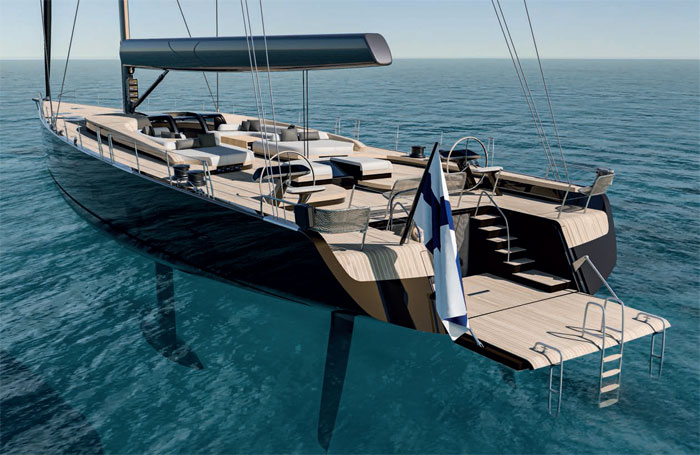
At anchor the deck plan provides two separate areas for the owners to enjoy and the transom folds out to reveal a large beach club
What carbon emission reductions are expected? ‘You would normally have a big main engine running at roughly 40 per cent load together with a generator running at about 60 per cent load,’ Kolam says. ‘Compare that to our serial hybrid system, with only one generator running at optimal load. Without calculating any CO2 numbers this is easy maths to understand that we will have less fuel consumption and lower CO2 emissions.’
Still under discussion at the time of writing, Baltic and McKeon have also developed a solar power solution in which photovoltaic panels are slid into pockets along the full length of the yacht’s over-the-boom sun awning, and potentially also in the bimini. ‘Whilst the yacht is stationary for extended periods the sun awning would be able to generate around 10kW of energy,’ McKeon says.
Another advantage of Baltic’s serial hybrid system is much lower levels of noise and vibration. ‘The big difference is that there is a sound shield on the genset and its rubber mount can be much softer than on a main engine,’ Kolam says. ‘Also one generator is much smaller and lighter than the main engine which means less vibration.’ ‘Noise reduction is an ongoing challenge that sees each yacht get quieter and quieter, which we achieve through attention to detail,’ Hawkins adds. ‘Having an electric motor on the end of the shaft as opposed to a diesel engine is a good start and a sound deadening pad inserted in the hull skin above the propeller helps reduce the prop wash noise under the hull.’
Sailing performance
It may be some time before the 110’s full potential is revealed on the racecourse but McKeon predicts excellent performance even in cruising mode: ‘The Baltic 110 will sail comfortably at speeds in excess of 12kts in light winds and easily exceed 20kts of boatspeed in a breeze.’
Click here for more information on Baltic Yachts »
We invite you to read on and find out for yourself why Seahorse is the most highly-rated source in the world for anyone who is serious about their racing.
To read on simply SIGN up NOW
Take advantage of our very best subscription offer or order a single copy of this issue of Seahorse.
Online at:
www.seahorse.co.uk/shop and use the code TECH20
Or for iPad simply download the Seahorse App at the iTunes store


